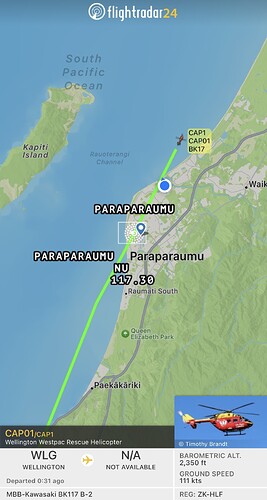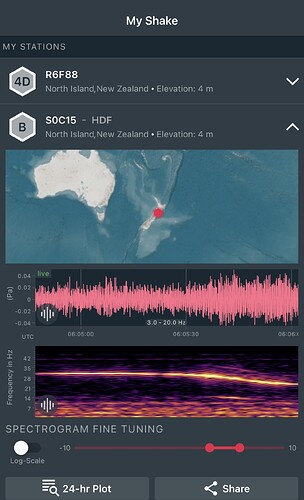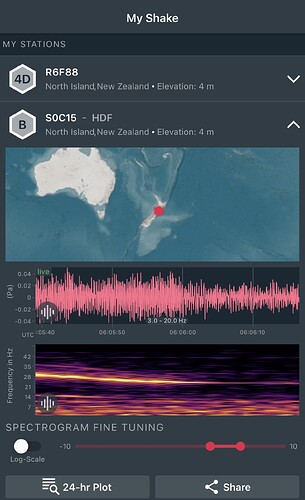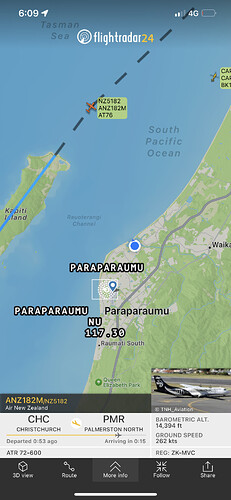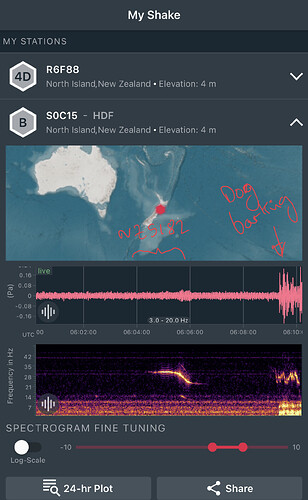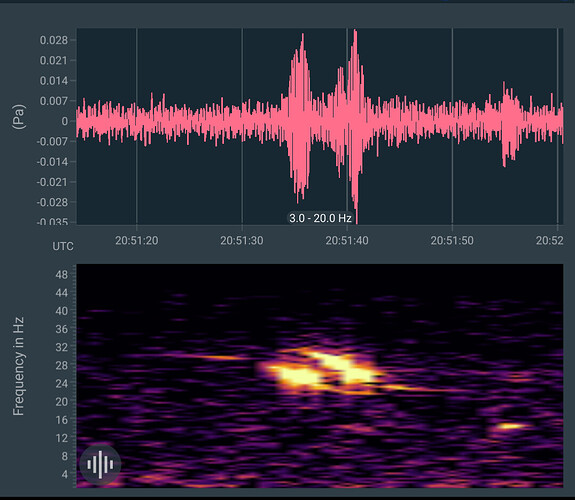Comparing Flightradar and ShakeBoom activity today. Followed a rescue helicopter from Wellington and the Boom heard it approach and pass over. Looks like it emits approx 30Hz on approach and overhead then drops down to 25Hz as it flys off. Also the Air NZ ATR turboprop at 14,000 ft was emitting a similar but much shorter duration Doppler signature. The noise to the right of that is the dog that decided to bark for no apparent reason - now I know what sets her off for random reasons - I should be able to correlate her barks to Flightradar ![]()
Helicopters direct the pulses from their rotors downwards - which rattles windows, walls etc. Because of this, they seem to be detectable further away that turbo-prop aircraft which are directing their prop pulses horizontally.
You might find this document useful.
doppler.pdf (76.0 KB)
Did not manage to capture a clear/clean turboprop signature yet (even if the local airport is close, but I am not on any approaching route), so this is very interesting!
Now that I know the local airport flight schedule I am hoping to catch one of the commercial regional flights. It’s also weather dependant as they don’t always take off north across my area.
They need to be fairly low and pretty much overhead. Most of the sound is (relatively) high frequency, so doesn’t show up.
Hello muedbundy, and welcome back to the community!
Very clear traces there, and really nice doppler shift pattern in the spectrogram!
indeed ![]() Thanks for the welcome back. I’m pretty busy all the time, not necessary on forums, but always keeping eyes on wave events.
Thanks for the welcome back. I’m pretty busy all the time, not necessary on forums, but always keeping eyes on wave events.
No trouble at all, and thank you for your continued enthusiasm in all things “Shake”!
I just uploaded a web page on the helicopter Doppler shifts I recorded here in New Hampshire. I analyze one of the clearest traces that came from a Sikorsky Black Hawk that was flying near its maximum safe speed and flew nearly directly overhead.
It includes graphics showing sound propagation from helicopter-like things (helicopters don’t reach Mach 0.9) and has the derivation of the frequency to speed equation that I just saw in doppler.pdf. I start from first principals - the wavelengths on the graphics.
Then I apply it to this flight and include a FlightRadar64 image of its track over my house (I’m at the “tt” in Sutton).
By the way, there’s a significant math error in Airwolf in Brittany as RS detects helicopters - Raspberry Shake . It assumes that the average of the arriving and departing frequencies is the frequency of the source. That’s false - averaging the wavelengths works as is clear on my graphics.
For my Black Hawk event, the frequencies I measured were 46 Hz dropping to 27 Hz. That leads to a source frequency of 34 Hz and therefore the arriving frequency is up by 12 Hz and the departing frequency is only 7 Hz down.
Hello Ric, and welcome back to our community!
Thank you so much for the super-detailed page you compiled and the clarification on the Airwolf post.
Reading through your data and explanations was really interesting, and I’m sure others in the community feel the same!
